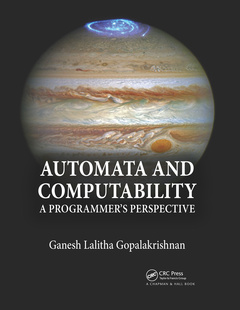Description
Automata and Computability
A Programmer's Perspective
Language: English
Subjects for Automata and Computability:
Keywords
SAT Solver; NFA State; theory of computation; Pushdown Automaton; autonoma; NFA; discrete math; Turing Machine; Python; Context Sensitive Language; Turing machines; Context Free Languages; lambdas; Boolean Satisfiability; automata theory; Deterministic Finite State Automaton; derivative-based parsing; Context Free Grammar; functional programming code; PDA; Lambda reducer; Mapping Reduction; Lambda Calculus; Regular Language; Lambda Expression; Re; Non-final State; BDD; Input String; DFA; Infinite Tape; States St1; Proof Sketch; Boolean Function; BDD
Publication date: 09-2020
· 21x28 cm · Paperback
Publication date: 02-2019
· 21x28 cm · Hardback
Description
/li>Contents
/li>Biography
/li>
Automata and Computability is a class-tested textbook which provides a comprehensive and accessible introduction to the theory of automata and computation. The author uses illustrations, engaging examples, and historical remarks to make the material interesting and relevant for students. It incorporates modern/handy ideas, such as derivative-based parsing and a Lambda reducer showing the universality of Lambda calculus. The book also shows how to sculpt automata by making the regular language conversion pipeline available through a simple command interface. A Jupyter notebook will accompany the book to feature code, YouTube videos, and other supplements to assist instructors and students
Features
- Uses illustrations, engaging examples, and historical remarks to make the material accessible
- Incorporates modern/handy ideas, such as derivative-based parsing and a Lambda reducer showing the universality of Lambda calculus
- Shows how to "sculpt" automata by making the regular language conversion pipeline available through simple command interface
- Uses a mini functional programming (FP) notation consisting of lambdas, maps, filters, and set comprehension (supported in Python) to convey math through PL constructs that are succinct and resemble math
- Provides all concepts are encoded in a compact Functional Programming code that will tesselate with Latex markup and Jupyter widgets in a document that will accompany the books. Students can run code effortlessly href="https://github.com/ganeshutah/Jove.git/"here.
I Foundations
1 What Machines Think
2 Defining Languages: Patterns in Sets of Strings
3 Kleene Star: Basic Method of defining Repetitious Patterns
II Machines
4 Basics of DFAs
5 Designing DFA
6 Operations on DFA
7 Nondeterministic Finite Automata
8 Regular Expressions and NFA
9 NFA to RE conversion
10 Derivative-based Regular Expression Matching
11 Context-Free Languages and Grammars
12 Pushdown Automata
13 Turing Machines
III Concepts
14 Interplay Between Formal Languages
15 Post Correspondence, and Other Undecidability Proofs
16 NP-Completeness
17 Binary Decision Diagrams as Minimal DFA
18 Computability using Lambdas
Ganesh Gopalakrishnan is a professor in the Computer Science Department at the University of Utah.




